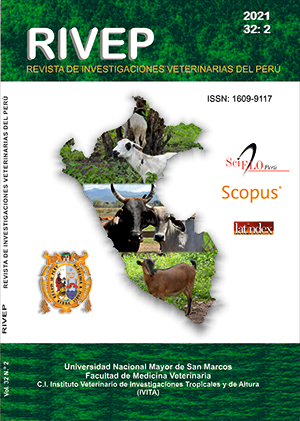Effect of entomopathogenic fungus Beauveria bassiana (balsamo) Vuillemin on the control of sheep ked (Melophagus ovinus)
DOI:
https://doi.org/10.15381/rivep.v32i2.18362Keywords:
biological control, false tick, sheep, efficacy, in vivoAbstract
Melophagus ovinus (sheep ked) is a common parasite of sheep, its control is based on chemical treatments; however, the environmental and public health consequences require the application of alternative treatments such as entomopathogenic fungi. The study aimed to determine the effect of the fungus Beuveria bassiana on the parasite in naturally infested sheep. Fifteen adult Hampshire crossbred sheep were used, randomly distributed in three spray treatments with dilutions: T1: 3.2 x108 conidia/ml, T2: 3.2x108 conidia/ml + 5% sugar and control T: distilled water. The daily parasites were counted on the animal to determine the population density and the efficacy of the treatments. The population density was controlled from day 14 with B. bassiana, reducing the presence of ked by 90% (T1 and T2), compared to 5.9% in the T Control (p<0.05). The study suggests that B. bassiana works with an efficacy of 89.3% for the control of M. ovinus.
Key words: biological control, false tick, sheep, efficacy, in vivo
Downloads
Downloads
Published
Issue
Section
License
Copyright (c) 2021 Adrián Hernando Valbuena Puentes, Adriana Marcela Galindo Soracá, Yefer Mauricio Boyacá Quintana

This work is licensed under a Creative Commons Attribution 4.0 International License.
AUTHORS RETAIN THEIR RIGHTS:
a. Authors retain their trade mark rights and patent, and also on any process or procedure described in the article.
b. Authors retain their right to share, copy, distribute, perform and publicly communicate their article (eg, to place their article in an institutional repository or publish it in a book), with an acknowledgment of its initial publication in the Revista de Investigaciones Veterinarias del Perú (RIVEP).
c. Authors retain theirs right to make a subsequent publication of their work, to use the article or any part thereof (eg a compilation of his papers, lecture notes, thesis, or a book), always indicating the source of publication (the originator of the work, journal, volume, number and date).










